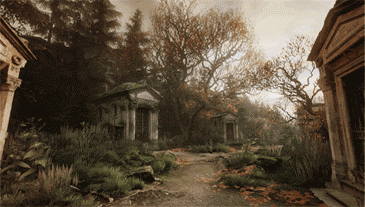How The Vanishing of Ethan Carter took over the Internet with three .gifs

We all saw the .gifs.
They emerged, phantom-like, toward the end of last year. A first-person glide around a forest at dusk, a slow saunter through an immaculate old cemetery, a train materializing on a track, then dissolving in mid-air—all produced with the sort of visual fidelity that usually requires a team of hundreds. The Vanishing of Ethan Carter was, the eight-person team at the Astronauts claimed, the product of a process called photogrammetry, which involved literally photographing real-world objects from multiple angles in order to almost programmatically recreate them in a digital space. The .gifs got people’s attention; their back-story fueled the fire.
Adrian Chmielarz, the Astronauts’ resident designer, is quick to throw water on it. “I think a lot of people might want to jump on the photogrammetry bandwagon because of the OMG NEXTGEN factor, but they should really consider the experience they want to offer first,” he told us. “You need something more than pretty graphics.”

To clarify, this is the man making the game saying this. Chmielarz’s sobriety is a nice inversion from the typical marketing-approved talking points about immersion and photorealism, but it’s still a bit jarring. His point is that graphical realism isn’t an end of itself, that any aesthetic choice needs to support a greater creative vision. “In our case, we wanted the player to [feel] a really strong sense of presence in the game world. There’s some supernatural stuff happening in Ethan Carter, and I loved the idea of putting it in contrast with [a] lifelike, realistic world.”It’s not just the fidelity, then, but this insistence upon context that the Astronauts have so carefully cultivated, and that made those .gifs so head-turning. In comics, this is called “closure”: the way we fill in the gaps from disparate unites. From the title to the austere mini-comic to, yes, those damn .gifs, The Vanishing of Ethan Carter projects a distinctly authored air. It speaks to a vision, with all the subtlety that entails. That Chmielarz and several of the other Astronauts are former People Can Fly decision-makers—and so have on their resumes some of the previous generation’s most bludgeoning, testosterone-soaked shooters—is all the more surprising. Though beautiful and, in many ways, refreshingly brisk, Bulletstorm seemed content to plumb the depths of the Sandler-MacFarlane spectrum of comedy, and after that the team went to work on an offshoot of the uber-man franchise Gears of War.

“Here’s the thing,” Chmielarz says, “it was the shooters that were the oddity for me, not adventure games. As soon as I learned how to code I wrote a couple of text adventures. Then my first commercial game, in 1993, was Mystery of the Statuette, a point-and-click thriller. Then my second game was Teenagent, a point-and-click spy comedy. Then it was The Prince and the Coward, a point and click fantasy game. I think I can see a pattern here!
“But somehow for the last ten years what I ended up doing were the shooters. Don’t get the wrong idea, I love them and I loved working on them and who knows, maybe one day I’ll make another. But even in that period we tried to do something that’s more focused on escapist storytelling.”
Escapism is a fair term for these games, which were, to be fair, cleanly designed and often painted in as much pink and orange as brown and dark-brown. But there’s something altogether more assured about their new work. In sports, they call this the leap; that moment when a player crystallizes as elite. In art, it’s called maturation, and it happens all the time. Cronenberg made an inconsequential racing movie before re-defining horror; Faulkner penned a couple lackluster potboilers before hitting his stride; Radiohead earnestly positioned themselves as guitar-rock for a whole album before turning into, you know, Radiohead. Could The Vanishing of Ethan Carter represent a similar leap for the Astronauts?
Who knows. All we’ve got are three .gifs, after all, and Chmielarz won’t be goaded to divulge more info about the game, beyond that, “I can vaguely point you in the general direction of the horror writers of the early 20th century.”

But he reveals his hand a bit more when talking about the freedom offered by his newfound independence from the traditional publishing system. “There’s some controversial stuff happening in Ethan Carter,” he says. “Stuff no big publisher would allow.” He references one of his older adventure games, the canceled Come Midnight, and a scene in which a man smoked a cigarette while holding a child, leading the child to cough. “It was (the) 1940s, and that was one of the ways to show how different that era was. But not only (did) the publisher (say) ‘absolutely not,’ we were forbidden to have any kind of moment in the game in which there was a child and a cigarette in the same room.” One immediately pictures The Vanishing of Ethan Carter’s teaser trailer—a slow, meandering shot of a man burning a stuffed bear, a handful of striped shirts, a tiny pair of shoes.
“And that,” Chmielarz says of the nixed baby coughing, “is nothing compared to some stuff we have in our game.”
Additional reporting by Cody Plepel



